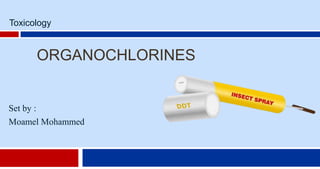
organochlorine toxicity.......pptx
- 1. ORGANOCHLORINES Set by : Moamel Mohammed Toxicology
- 2. Introduction Organochlorines (OCs) are organic molecules with chlorine in their structure ( chlorinated hydrocarbons) In general they are non-volatile solids at room temperature Organochlorine compounds usually have a large molecular mass. They are very stable and are moderate polarity. This makes OC easily soluble in fats. They were found in all environments: air, water, soil, sediments, and biota samples.
- 3. Organochlorines pesticides (OCPs) Most organochlorines have a negative temperature coefficient meaning they are more toxic at lower temperatures. This property makes organochlorine agents more toxic to cold-blooded creatures like insects and mammals. Organochlorine pesticides are used extensively from the 1940s through the 1960s in agriculture and mosquito control. The compounds in this group include: DDT(dichlorodiphenyltrichloroethane), methoxychlor, toxaphene, mirex, kepone, lindane, cyclodine, and benzene hexachloride. As neurotoxicants, many organochlorine pesticides were banned in the United States and other countries.
- 4. Signs and symptoms CNS excitation and depression, are the primary clinical effects of acute organochlorine toxicity; therefore, patients may present with any of the following: Initial euphoria with auditory or hallucinations. Seizures Agitation or unconsciousness Facial paresthesia Inability to close eyelide Drooping the mouth Facial nerve Facial paresthesia
- 5. Other signs and symptoms include the following: Pulmonary - Cough, shortness of breath Dermatologic - Skin rash Gastrointestinal - Nausea, vomiting, diarrhea, and abdominal pain Nervous system - Headache, dizziness . .
- 6. Route of Exposure There are three types of exposure: dermal, inhalation, and ingestion. Dermal exposure is the most common type of exposure for the applicator. the skin is easily exposed when handling pesticides. Inhalation or breathing a pesticide into the lungs is less common, but is still a danger to the applicator. Ingestion exposures occur when users eat, smoke, or drink around pesticides or forget to wash after use. other parts of the body (eyes, abdomen, groin) absorb pesticides more quickly.
- 7. Ingestion produces the following manifestations: Nausea and vomiting Confusion, tremor, myoclonus, coma, and seizures Respiratory depression or failure Skin absorption or inhalation produces the following manifestations: Ear, nose, and throat irritation Blurred vision Cough, Acute lung injury Dermatitis Eczema by pesticide
- 8. Organochlorines affect nerve impulse transmission by altering membrane Na+ K+ flux, resulting in CNS hyperexcitability. Organochlorines produces myocardial irritability and cardiac arrhythmias. Mechanism of Toxicity DDT(dichlorodiphenyltrichloroethane) and related compounds act on sodium channel and sodium conductance across the neuronal membrane, especially of axones. Cyclodine and Lindane appear to inhibit the GABA mediated chloride channels in CNS.
- 10. An oral median lethal dose (LD50) is higher than 50 mg/kg in animal studies. The estimated approximate minimum lethal dose for humans is 2-7 g LD50 and toxicity rating LD50 in the rats 113-800 mg/kg DDT 88-190 mg/kg lindane 100-210 mg/kg cyclodine
- 11. Toxicity tests The normal range for blood chlorine in most laboratories is 96 to 106 milliliters per liter. Diagnostics may use a chlorine meter to determine the level of chloride in the blood. If chloride level in the blood is more than 106 it will cause hyperchloremia.
- 12. No specific antidotes are available for organochlorine poisoning. Decontamination may be indicated to prevent continued absorption, as well as exposure of health care personnel. For dermal decontamination, remove clothing and wash skin with soap and water. This is best performed in the field. the medications used in relieve symptomes include gastrointestinal decontaminants, beta-blockers, vasopressors, and benzodiazepines and other anticonvulsants. Antidote and treatment
- 13. https://www.cdc.gov/exposurereport/pdf/fourthreport.pdf https://www.epa.gov/safewater/dwh/c-soc/lindane.html https://www.atsdr.coc.gov/tfacts31.html https://emedicine.medscape.com/article/815051-overview https://www.researchgate.net/journal/Canadian-Journal-of-Physiology- and-Pharmacology-1205-7541 https://cdnsciencepub.com/doi/10.1139/y66-017 https://www.ucsfhealth.org/medical-tests/chloride-test---blood References
- 14. • Thank you